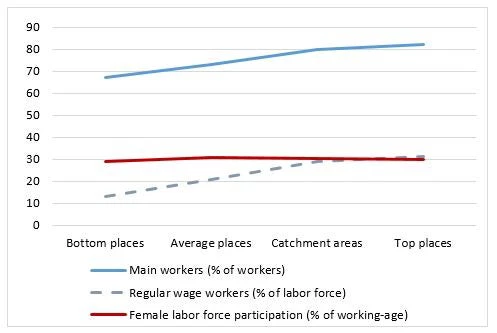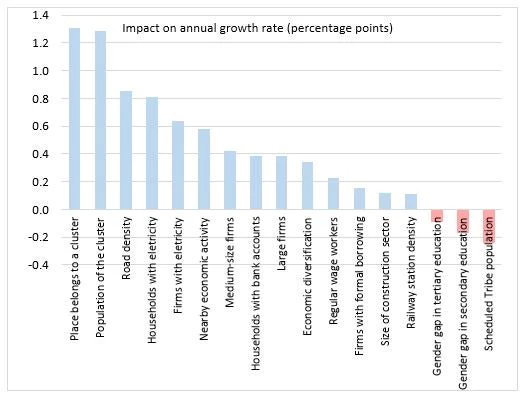
Blog 12: Key lessons on road to sharing prosperity
India is home to the largest number of poor people in the world, as well as the largest number of people who have recently escaped poverty. Over the last few weeks, this blog series has highlighted research from the World Bank and its partners on what has driven poverty reduction, what still stands in the way of progress, and the road to a more prosperous India.
This is the last blog in the #Pathways2Prosperity series. You can read all the blogs in this series and keep contributing to the discussion around #WhatWillItTake to #EndPoverty in India.
A thorough review of India’s experience in reducing poverty over the last two decades confirmed some of our previous understanding, but it also revealed new, unexpected insights. On the confirmation side, we found that poverty in India, as in other parts of the world, is associated with a lack of assets at the household level, and especially with limited human capital.
At the national level, 45 percent of India’s poor are illiterate, whereas another 25 percent have a primary education at most. Further down several Indian states, including a few high-income ones, show stunting and underweight rates that are worse than the averages for sub-Saharan Africa. While multiple factors lie at the root of the nutrition challenge, the prevalence of diarrheal disease is thought to be one of the main culprits, and diarrhea is triggered by poor hygiene. Only 6 percent of India’s poor have tap water at home, and a little more than a fifth have a latrine or some form of improved sanitation.
From this perspective, investing in education, health and the delivery of basic services for India’s most disadvantaged people remains a key priority. Investments of this sort would enhance the human capital of the poor, hence increase their chances to prosper.
However, one new insight that emerges from this review is that returns to household assets vary dramatically depending on where a household lives and that, given the right environment, even those with limited human capital can lift themselves out of poverty. This finding will come as no surprise to migrant workers, who know how much their odds in life would improve if they could make it to a rich country. What is striking, however, is how different the odds can be even within India. As pointed out in an earlier article in this series, an ‘average’ Indian household consumes Rs 2,928 per month in a small village in the Malkangiri district of Odisha; but in urban Gurgaon, its consumption would be more than four times greater, reaching Rs 13,554 per month.
Our findings show that across India, a range of top places offers much better opportunities to progress in life. These places are, however, very unevenly distributed over the map. Most of them are to be found in the northwestern part of the country, or along the western and southwestern coasts. In the Ganga basin, on the other hand, and in low-income states more generally, such places are few and far between. Interestingly, some of these top places, like Delhi, spread their wealth over vast catchment areas, while others, like Bangalore, are more self-contained.
Another important insight from this research is related to the nature of these top places in India. While large cities are clearly more prosperous than small villages, the overall picture is more complex than the standard notion of the rural-urban divide would suggest. Granted, major cities are among India’s top places. But quite a few top places are administratively rural, and some of the best in terms of living standards are actually secondary cities. Besides, the top places often spread their opportunities far beyond their administrative boundaries, benefitting many villages that fall within their wider catchment areas. This may explain why urban growth has become such an important driver of rural poverty reduction over the past two decades.
What makes these top places and catchment areas special is the job opportunities they provide. For, labor earnings are the primary drivers of poverty reduction in India. This is not to say that transfers and social programs are unimportant. But labor earnings, from both self-employment and wage employment, account for nearly 90 percent of household income. And their increase has been the most significant contributor to higher household expenditures per capita in recent years. Important distinctions also need to be made between types of jobs. Casual employment, such as daily work in construction, has been instrumental in lifting households out of poverty. Regular wage employment, whether formal or informal, has been the real ticket to the middle class.
Top places are characterized by fewer marginal jobs, and more regular wage employment. Importantly, while female labor force participation rates decline when moving from rural to urban areas, they do not do so when moving from bottom and average places to top places and their catchment areas.

The question then is: what would be needed to create more of these top places across India, and to get living standards elsewhere to converge and catch up? This is a critically important area for policy, but one that is intrinsically different from investing in education and health, or from providing transfers and social programs. Answering this question requires nailing down the characteristics of those places that have seen their living standards grow faster than average.
At the state level, there is little convergence in India. With the possible exception of Rajasthan, and most recently Bihar, low-income states grow more slowly than the rest of the country. This is a matter of particular concern, given that they are home to nearly 62 percent of its poor. Small rural places are not catching up either. But household expenditures per capita have grown faster in large rural places and small towns (the mid-range of the rural-gradation) than in large cities.
The experience of the last decade reveals that places that did well have several characteristics in common. The most important predictor of growth is belonging to an urban cluster - preferably one with a large population, like Delhi and its surroundings. The second most important predictor is related to infrastructure, and includes access to electricity and the density of roads. Places with a larger share of medium and large size firms also grow faster, as do places with a more diversified economic structure. Last but not least, inclusion seems to contribute to faster growth: places with low literacy rates and primary school enrollment, or with large gender gaps in education, grow more slowly.

It is equally important to identify who can actually help create more of these top locations across India. It is not enough to know that investments in infrastructure and education, or a conducive business environment, make a difference. A local authority also needs to be empowered to make the changes happen. Unfortunately, that kind of empowerment is not consistently found across India’s rural-urban gradation.
Clearly, a lot lies in the hands of chief ministers who have the power to engineer and lead their states’ turnaround. A lot also lies in the hands of urban authorities, who can transform their cities into top places. Bangalore and Delhi, for instance, have done this successfully. For cities that are not state capitals, however, this transformation can be more difficult, as they do lack the authority to coordinate investments and spending across sectors.
More worryingly, some places that are in dire need of action do not seem to have anyone who is fully empowered to take it. Tribal areas, and the many rural communities that could more fully benefit from the proximity of top places, fall into this category.
Reference: Chatterjee, Urmila, Rinku Murgai, Ambar Narayan and Martin Rama (2016) " Pathways to reducing poverty and sharing prosperity in India: Lessons from the last two decades. " World Bank.
This blog was originally published in the Indian Express on 17th August, 2016.


Join the Conversation